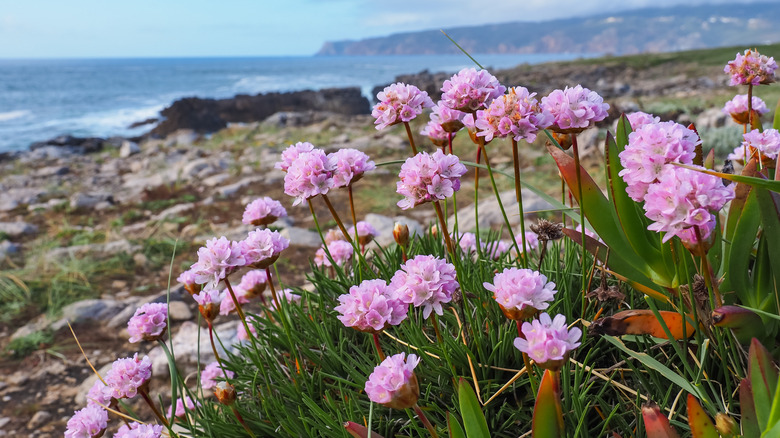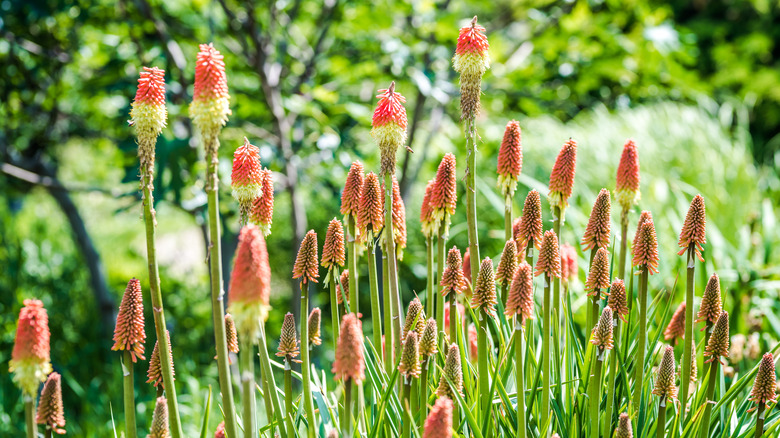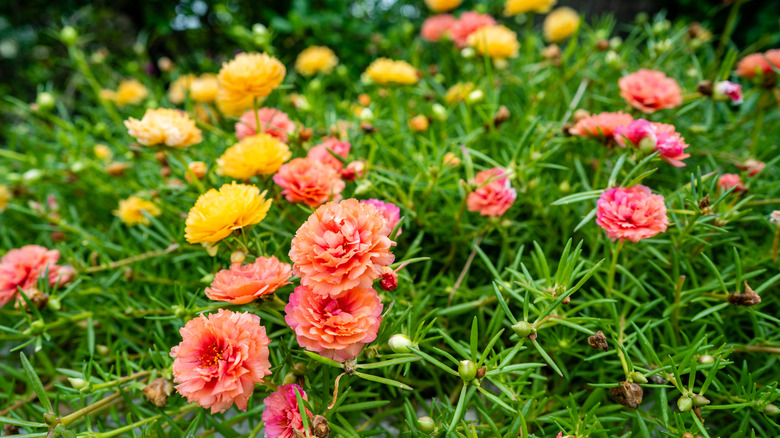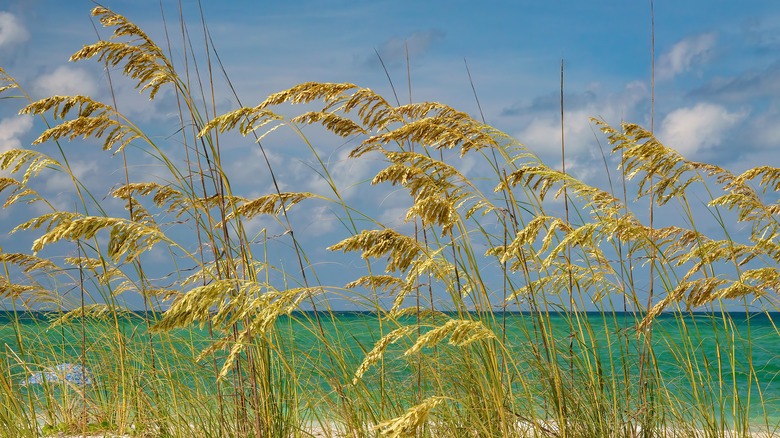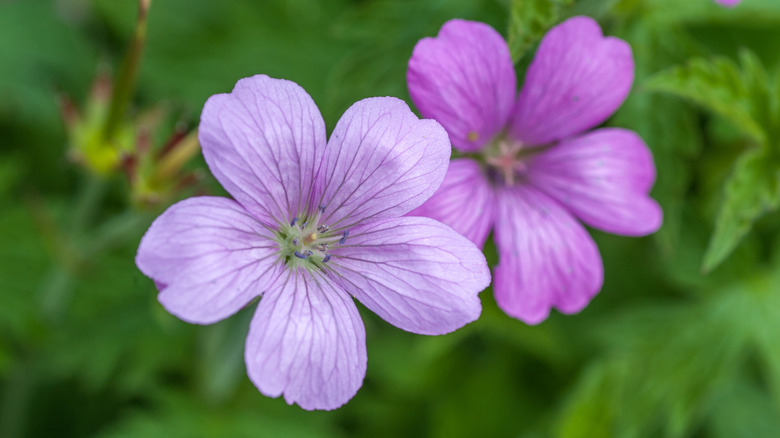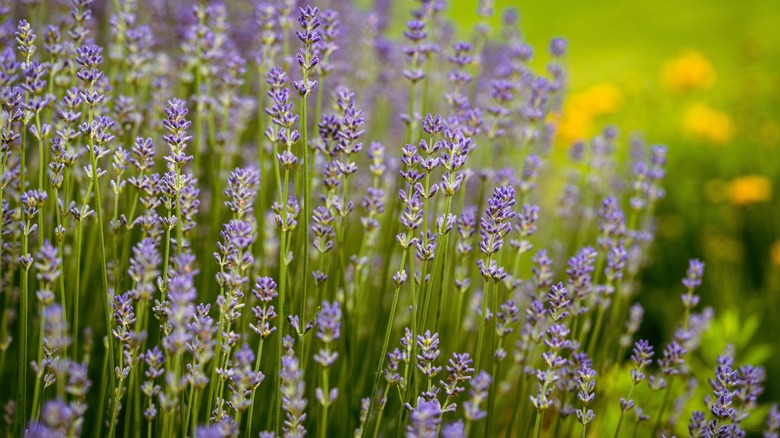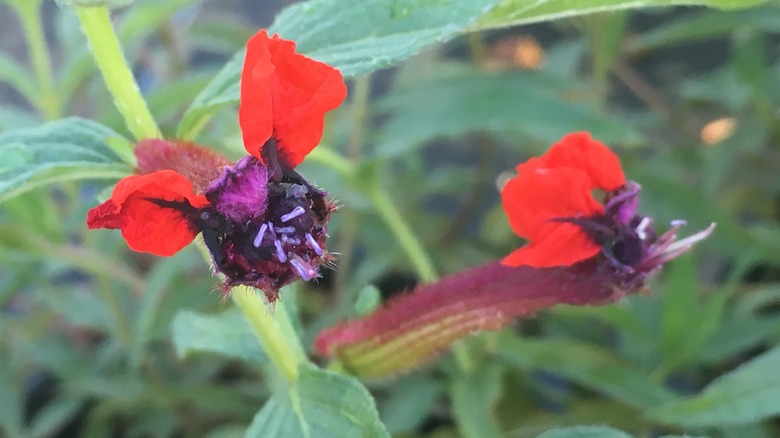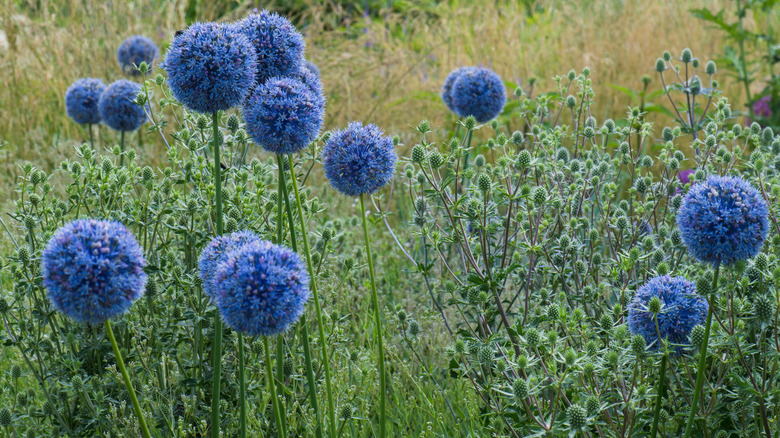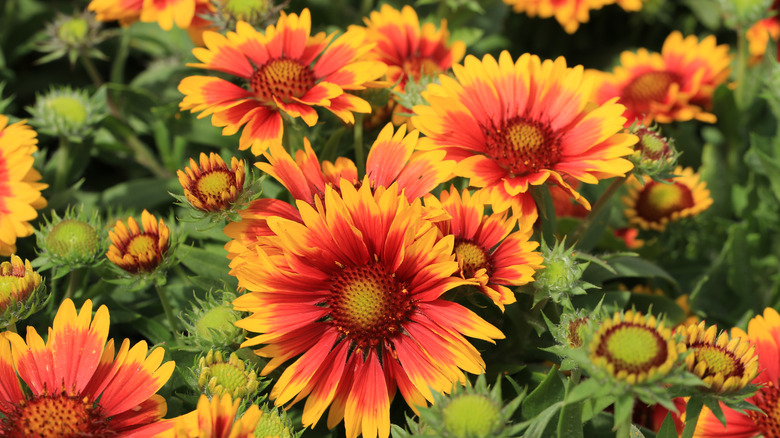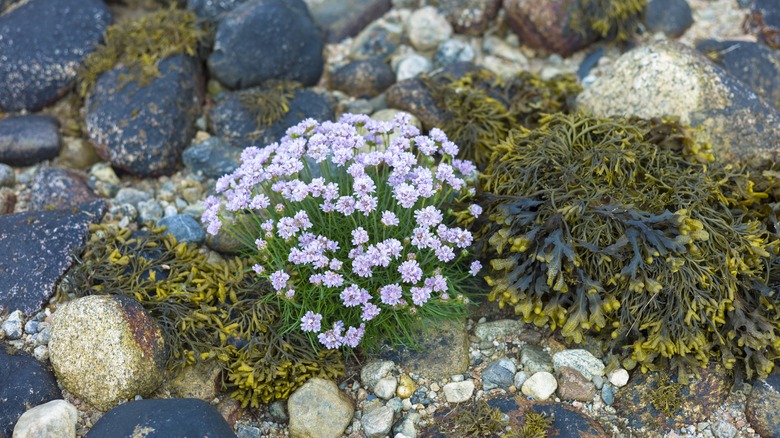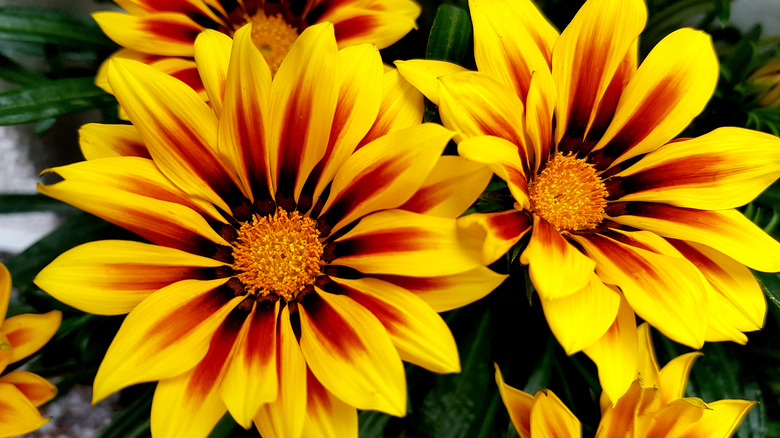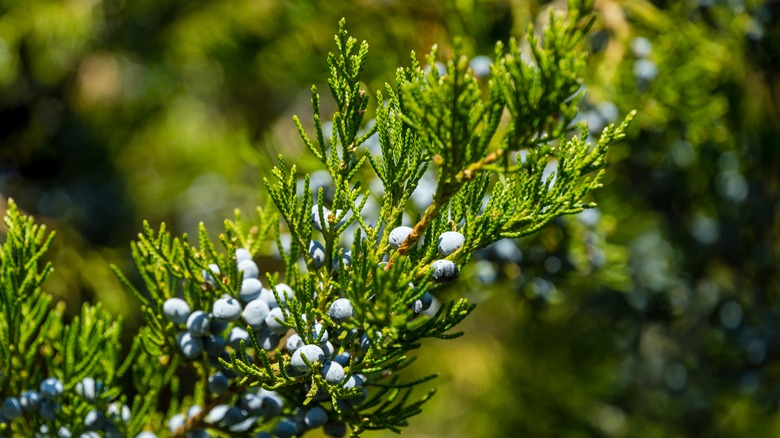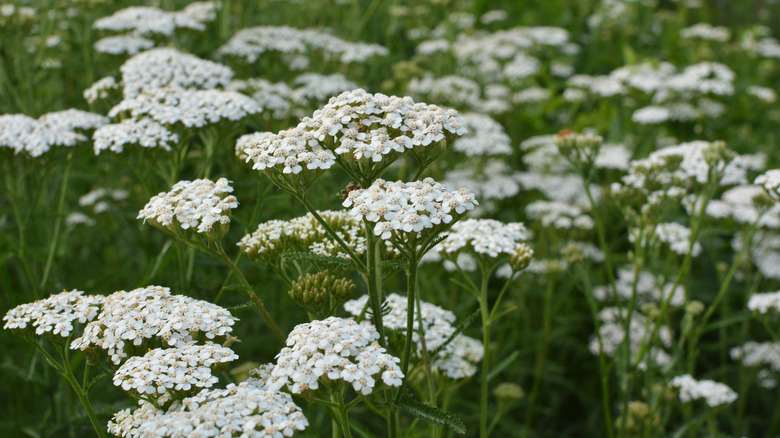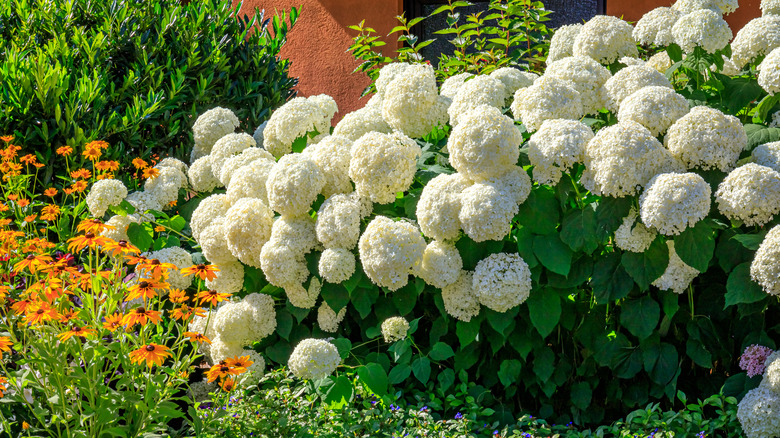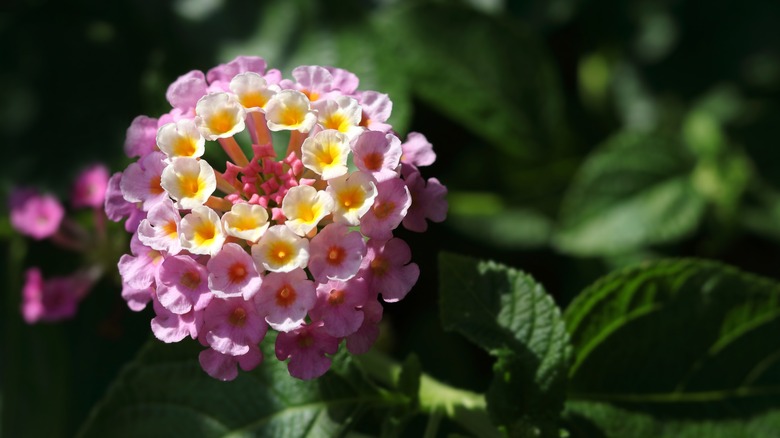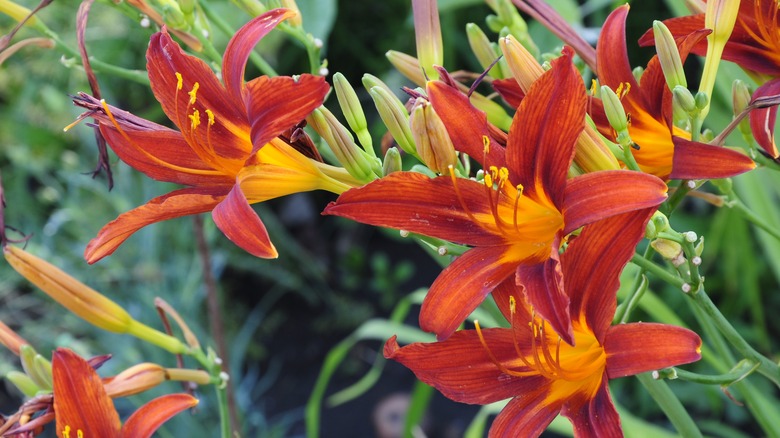15 Flowering Plants That Thrive Near The Coast
It's hard to think of anything more beautiful than the view of the ocean from a home on the coast. However, some cheery blooms could make it a bit prettier. Flowers that grow easily on the coast can be difficult to find. As explained by The Wildlife Trusts, many plants cannot tolerate the salt in the air, the sandy soil, or the windy conditions near the beach. Still, it isn't impossible to find flowering trees, bushes, herbs, and ornamental grasses that are right for the job. In fact, there are quite a few good options for coastal gardeners if they know where to look.
Unsurprisingly, most flowers that are planted in gardens near the coast do well in a range of environments. They tend to be native to North or South America and suitable for growing in a few different types of soil. Nutrient-poor sand can be a difficult medium for some plants to grow in, but all the bright flowers in this collection have adapted to the salty climate which needs a little more life.
1. Torch lily
Torch lilies (Kniphofia uvaria) are a fast-growing herbaceous perennial that grows well in enriched soil in a location that does not experience harsh winters, as per Monrovia. On the coast, you can find torch lilies growing in Mediterranean, rustic, or cottage gardens that support their environmental requirements and their unique aesthetic.
Bloom Season: Summer to fall
USDA Growing Zone: 6 to 9
Growing Conditions: Full sun
Soil Type: Enriched and well-draining
Size: 20 inches tall and 14 inches wide
2. Moss rose
The moss rose (Portulaca grandiflora) is a nyctinastic South American plant that only opens its blooms when the sun is shining. During the night and on cloudy days the red, pink, purple, orange, yellow, or white flowers stay closed, as described by North Carolina State Extension. Make sure to plant your moss roses in a full sun location with well-draining soil for the best blooms.
Bloom Season: Spring to summer
USDA Growing Zone: 2 to 11
Growing Conditions: Full sun
Soil Type: Well-draining
Size: 3 to 8 inches tall and 1 foot wide
3. Sea oats
Sea oats (Uniola paniculata), which are considered invasive in some states, are actually endangered. These herbaceous ornamental plants once lined the east coast and stabilized the sand dunes, according to the University of Florida. Today, planting sea oats along east coast beaches is encouraged.
Bloom Season: Spring and summer
USDA Growing Zone: 7 to 11
Growing Conditions: Full sun
Soil Type: Well-drained and sandy
Size: 5 to 8 feet tall and 1 to 2 feet wide
4. Wild geranium
Wild geraniums (Geranium maculatum) are a versatile species that can be used in pollinator gardens, native gardens, or used as ground cover. This native flower has a long history in the United States. It grows well in several regions and parts of the plant can be used as medicine. This was discovered first by Native Americans who used it to treat diarrhea, open wounds, and other ailments, according to the University of Wisconsin-Madison.
Bloom Season: Spring to summer
USDA Growing Zone: 3 to 8
Growing Conditions: Partial to full shade
Soil Type: Well-draining
Size: 1 to 2 feet tall
5. Lavender
Lavender plants (Lavandula angustifolia) are a good option for almost any type of garden. They grow happily in average soil as long as they receive plenty of direct sunlight, as said by Missouri Botanical Garden. However, sandy soil is preferred, which makes it perfect for coastal gardens. This is a wonderful, versatile plant that will provide you with aromatic leaves and flowers as long as you care for it properly.
Bloom Season: Summer
USDA Growing Zone: 5 to 8
Growing Conditions: Full sun
Soil Type: Low fertility, alkaline, and well-draining
Size: 3 feet tall and 4 feet wide
6. Bat-faced cuphea
Bat-faced cuphea (Cuphea llavea) is an unusual plant featuring small flowers that resemble the face of a bat, hence the common name. The Cuphea genus, as explained by the University of Wisconsin-Madison, hosts more than 260 species of flowering plants that share some traits with the bat-faced cuphea. All species enjoy warm weather and direct sunlight, and they bloom for a long time through the spring and fall.
Bloom Season: Spring
USDA Growing Zone: 9 to 12
Growing Conditions: Full sun
Soil Type: Well-draining
Size: 12 to 18 inches tall
7. Ornamental onion
The ornamental onion (Allium caeruleum) grows well in gritty or sandy soil near the coast. This plant can be identified by its long stems and its clusters of star-shaped flowers that form a ball on the flower head, as described by Missouri Botanical Garden. When growing this flower, be sure to grow it in a dry and sunny part of your garden.
Bloom Season: Summer
USDA Growing Zone: 4 to 8
Growing Conditions: Full sun
Soil Type: Rich and well-draining
Size: 1 to 2 feet tall and 6 to 12 inches wide
8. Blanket flower
The blanket flower (Gaillardia spp.) is grown around the United States for its gorgeous blooms that appear in the summer and for its ability to survive cold weather. This plant is native to North and South America where it thrives in coastal and mountainous areas, as noted by North Carolina State Extension.
Bloom Season: Summer to fall
USDA Growing Zone: 3 to 9
Growing Conditions: Full sun
Soil Type: Well-draining loam or sand
Size: 48 inches tall and 30 inches wide
9. Sea thrift
Sea thrift (Armeria maritima) is best planted on the coast where other perennials can't handle the salty environment, says the University of Wisconsin-Madison. This short, herbaceous plant is characterized by many needle-shaped green leaves and pink, lavender, or white flowers that blossom in the spring. Sea thrift, also known as sea pink, makes a good addition to a rock garden or another well-draining and gravelly garden.
Bloom Season: Spring
USDA Growing Zone: 4 to 8
Growing Conditions: Full sun
Soil Type: Lean and well-draining
Size: 6 to 12 inches tall
10. Treasure flower
The treasure flower (Gazania rigens), which looks similar to the African daisy, is an annual that shows off orange and yellow blooms in the summer and fall. This plant looks best in autumn gardens where its petals can reflect the changing of the seasons. Jersey-Friendly Yards recommends planting your treasure flowers in dry, sandy soil for the strongest growth.
Bloom Season: Summer to fall
USDA Growing Zone: 6 to 7
Growing Conditions: Full sun
Soil Type: Dry sandy loam
Size: 6 to 12 inches tall and wide
11. Juniper
Juniper (Juniperus virginiana), also called the Eastern redcedar, is a highly salt-tolerant tree that grows well along the coast. When left to itself, it can become as tall as 40 feet, but there are also shorter growing cultivars such as "Glauca Compacta." All varieties of the juniper tree do well in the garden, but you should be careful of its fruit, flowers, and leaves which are poisonous, as per North Carolina State Extension.
Bloom Season: Spring
USDA Growing Zone: 2 to 9
Growing Conditions: Full sun to partial shade
Soil Type: Well-draining
Size: 30 to 40 feet tall
12. Yarrow
The yarrow plant (Achillea millefolium) goes by a few different names, including soldier's woundwort, devil's nettle, old man's pepper, and thousand seal. Clemson Cooperative Extension calls the flowering perennial a habitat for insects such as butterflies and ladybugs. This makes it a good choice for coastal pollinator gardens and native gardens.
Bloom Season: Mid-spring to summer
USDA Growing Zone: 3 to 9
Growing Conditions: Full sun to partial shade
Soil Type: Nutrient-poor and dry
Size: 3 feet tall and 1 foot wide
13. Hydrangea
Hydrangeas (Hydrangea macrophylla) are commonly grown for their giant clusters of bright flowers and their bushy growth habit. They can be planted in a range of soils and environments, as per North Carolina State Extension. Grow them in clay and sandy soil, or in regions with salty air. It is also tolerant of direct sunlight if given plenty of water.
Bloom Season: Summer
USDA Growing Zone: 6 to 11
Growing Conditions: Dappled sunlight to full shade
Soil Type: Evenly moist and well-draining
Size: 3 to 6 feet tall and wide
14. Lantana
Lantana (Lantana camara) is a gorgeous flowering plant that will welcome hummingbirds, honey bees, and butterflies to your home garden. According to the University of Wisconsin-Madison, the small shrub can blossom in a few warm colors, including red, yellow, pink, and orange. Typically, they bloom in the spring and last until frost, when they are well cared for.
Bloom Season: Spring
USDA Growing Zone: 8 to 10
Growing Conditions: Full sun
Soil Type: Well-drained
Size: Up to 6 feet tall, smaller when container-grown
15. Daylily
Daylilies (Hemerocallis spp.) are widely known for their incredible blooms that typically appear in red, orange, or yellow, as told by Jersey-Friendly Yards. They work well in pollinator gardens as their trumpet-shaped blooms hold nectar for butterflies and hummingbirds. Don't be afraid to plant daylilies in your garden if you live near the coast. They have a high salt tolerance and they enjoy growing in loamy sand.
Bloom Season: Summer to fall
USDA Growing Zone: 6 to 7
Growing Conditions: Full sun
Soil Type: Well-draining
Size: 1 to 3 feet tall and 1 to 2 feet wide
